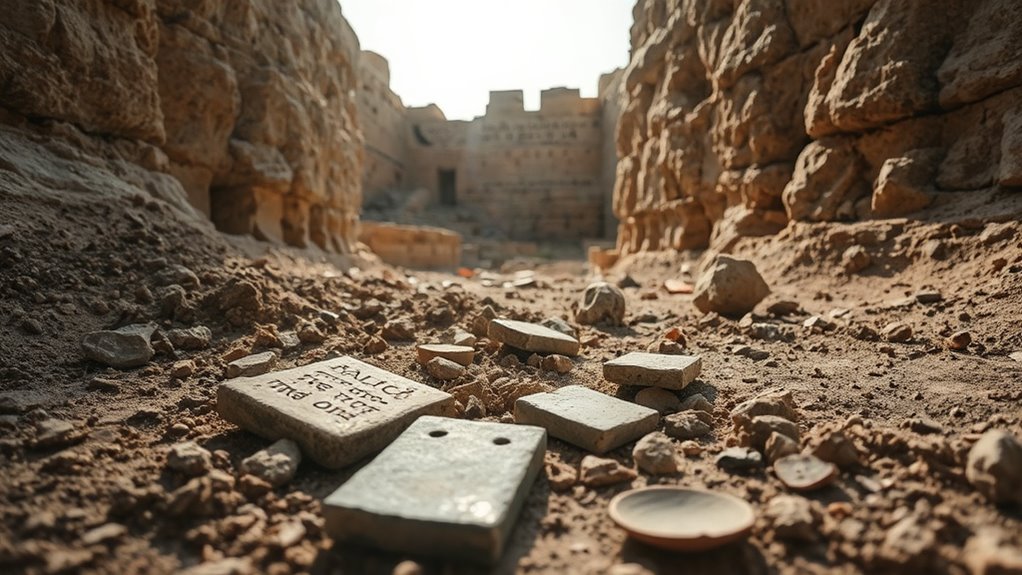The Bible’s reliability is backed by archaeological discoveries of ancient cities and artifacts that match its accounts, as well as inscriptions like the Tel Dan Stele and Siloam Inscription confirming biblical figures. Its manuscript evidence shows consistent transmission over centuries, with only minor errors that don’t change core messages. Many prophecies have come true, pointing to divine inspiration. External sources also support its historical accuracy. To understand more, explore how these facts reinforce the Bible’s trustworthiness.
Key Takeaways
- Archaeological discoveries confirm biblical locations and artifacts, supporting the historical reliability of biblical events.
- Manuscript evidence shows the Bible has been accurately preserved with minimal, non-essential textual variations.
- Many biblical prophecies have been fulfilled, demonstrating divine insight and the Bible’s prophetic reliability.
- External historical sources and inscriptions corroborate biblical narratives and figures outside of scripture.
- Careful translation and cultural influence affirm the Bible’s consistency, trustworthiness, and ongoing relevance.
Historical Consistency of Biblical Accounts

Many skeptics question whether the biblical accounts are historically accurate, but a closer look shows that the Bible consistently aligns with archaeological findings and external historical sources. Understanding the cultural context helps clarify how ancient societies viewed events, making biblical narratives more credible. Additionally, the literary style used in these texts reflects their historical roots, often blending history with poetic and theological elements that resonate with the cultural norms of the time. This consistency in cultural backdrop and literary style strengthens the argument for the Bible’s historical reliability. Recognizing the archaeological evidence and its correlation with biblical records reveals a deliberate effort to record real events within a genuine cultural framework, supporting its historical integrity. Furthermore, ongoing discoveries continue to reinforce the Bible’s role as a credible historical document. These archaeological findings serve as tangible proof that the biblical narratives were rooted in actual historical events and contexts, demonstrating how the biblical authors employed historical accuracy in their storytelling to establish trustworthiness. The convergence of biblical accounts with external sources affirms the reliability of these texts in recounting historical realities.
Archaeological Discoveries Supporting Biblical Events

Archaeological discoveries have uncovered ancient cities and artifacts that align with biblical accounts, lending credibility to the events described. Confirmed inscriptions provide direct evidence linking historical records to biblical narratives. These findings help you see how archaeology supports the reliability of the Bible’s historical claims. A focus on historical accuracy demonstrates the careful preservation of biblical events through archaeological evidence. Additionally, ongoing excavations continue to reveal ancient texts and artifacts, further strengthening the case for the Bible’s trustworthiness as a historical document. Studies of cultural context also contribute to understanding how these discoveries reinforce biblical history. The integration of creative practice principles can be metaphorically applied to preserving and protecting this invaluable historical knowledge.
Excavated Ancient Cities
Discovering ancient cities through excavation has provided compelling evidence that supports the events described in the Bible. By uncovering ancient city ruins with advanced excavation techniques, archaeologists confirm biblical accounts and reveal historical contexts. These discoveries include well-preserved structures and artifacts that match biblical timelines. The table below highlights key excavated cities and their significance:
| City | Key Findings |
|---|---|
| Jericho | Wall collapse supporting conquest |
| Hazor | Large destroyed city, biblical battles |
| Beth Shean | Well-preserved Roman and biblical layers |
| Lachish | Seige evidence aligning with scripture |
| Megiddo | Strategic city with layered ruins |
These excavations continue to validate biblical narratives, demonstrating that the Bible reflects real historical events. The archaeological findings further strengthen the connection between the biblical stories and historical evidence, providing a tangible link to the past. Additionally, archaeological methods have evolved to uncover more detailed and accurate information, enhancing our understanding of biblical history. Excavation techniques now allow for more precise dating and contextual analysis, increasing confidence in these discoveries, and ongoing excavations are expected to uncover even more historical artifacts. The integration of scientific dating methods further bolsters the reliability of these archaeological results.
Confirmed Biblical Inscriptions
Confirmed biblical inscriptions serve as tangible evidence that supports the events described in the Bible. These ancient inscriptions, carved into stone or clay, provide direct links to biblical figures and occurrences. Archaeological inscriptions such as the Tel Dan Stele mention the “House of David,” confirming King David’s historical existence. Similarly, the Siloam Inscription describes the construction of the Siloam Tunnel during King Hezekiah’s reign. These inscriptions authenticate biblical narratives, transforming them from faith-based stories into historically supported events. By examining these archaeological inscriptions, you gain confidence that the Bible records real people and moments in history, offering compelling evidence that the scriptures are more than mere legend. They serve as a vital bridge between faith and verifiable history. Historic evidence also plays a crucial role in validating the accuracy of biblical accounts. Additionally, the discovery of inscriptions related to biblical events strengthens the historical reliability, and ongoing excavations continue to uncover new artifacts that support biblical stories, further enhancing our understanding of ancient history. These discoveries demonstrate how archaeological findings continually reinforce the trustworthiness of biblical records.
Artifacts Supporting Events
Artifacts discovered through archaeological excavations provide tangible support for biblical events, transforming historical claims into verifiable facts. Ancient artifacts, such as pottery, tools, and inscriptions, help confirm the historical context of biblical narratives. Biblical inscriptions, inscribed on walls or artifacts, offer direct evidence of events, people, and places mentioned in Scripture. For example, the Tel Dan Stele references the “House of David,” supporting the biblical account of King David’s dynasty. Similarly, artifacts like the Pilate Stone verify the existence of Pontius Pilate, connecting biblical figures to real history. These discoveries bridge the gap between faith and history, reinforcing the reliability of biblical accounts through tangible, archaeological evidence. They serve as vital links that validate the events described in Scripture and emphasize the importance of biodiversity in understanding the richness of ancient environments that shaped these historical contexts. The preservation of these artifacts also highlights the significance of archaeological methods in uncovering and interpreting historical data.
Manuscript Evidence and Textual Transmission

You should consider how manuscript variants impact the trustworthiness of the Bible’s texts. Despite some differences, the overall accuracy and consistency of transmission over time remain impressive. These factors help affirm the reliability of the biblical message through centuries of copying. Manuscript evidence, such as those listed for various stores, demonstrate how consistency in schedules can be crucial for planning visits and maintaining trust in service providers. Additionally, understanding the textual transmission process reveals how careful copying and preservation have contributed to the Bible’s integrity over centuries. The preservation techniques employed by scribes have played a significant role in maintaining the text’s fidelity across generations. Moreover, the vetted nature of these manuscripts underscores the meticulous efforts made to ensure accurate transmission of the scriptures.
Manuscript Variants and Accuracy
Manuscript variants are differences that appear in the numerous copies of biblical texts, reflecting the natural process of copying over centuries. These are known as textual variants, and they occur when scribes inadvertently make mistakes or introduce slight changes during transcription. Common scribal errors include misspellings, skipped words, or accidental repetitions. While these variations can seem concerning, most are minor and do not alter the core message or doctrine of the Bible. Textual criticism helps scholars compare thousands of manuscripts to identify and correct these errors, ensuring the text’s reliability. Overall, the abundance of manuscript evidence and the ability to cross-reference variants affirm the accuracy of the biblical text despite the presence of scribal errors.
Transmission Consistency Over Time
Despite the centuries that have passed since the original biblical texts were written, the consistency of the manuscripts demonstrates remarkable stability. This is due to careful manuscript preservation efforts and meticulous attention to translation accuracy over generations. You can trust that the core messages have remained intact, despite minor variants. This consistency provides reassurance that the Scriptures you read today closely reflect the original writings.
- The thousands of ancient manuscripts attest to faithful transmission through careful copying.
- Variants are minor and do not compromise essential doctrines or historical facts.
- Modern translations are based on the most reliable manuscript evidence, ensuring accuracy.
This remarkable preservation highlights the reliability of the biblical text, making it trustworthy for your faith and understanding.
Fulfillment of Biblical Prophecies

The fulfillment of biblical prophecies provides compelling evidence for the Bible’s reliability. You can see impressive prophetic accuracy in how past predictions have come true, strengthening your confidence in its divine inspiration. The Bible’s detailed future predictions, such as the destruction of ancient empires or the coming of a Messiah, demonstrate extraordinary foresight. These fulfilled prophecies aren’t coincidental; they reveal a higher knowledge guiding the scriptures. When you examine these fulfilled prophecies, you realize they serve as a powerful validation of the Bible’s divine origin. This consistency between prophecy and history affirms that the scriptures are trustworthy, making it clear that divine guidance is woven throughout the text, not just human invention.
The Reliability of Biblical Translations

Because the Bible has been translated into numerous languages over centuries, its reliability depends on careful and accurate translation processes. When translation accuracy is prioritized, the core message remains faithful, even across different cultures and eras. Modern language translations help you understand Scripture clearly and relate personally to its teachings. You can trust that:
- Precise translation preserves the original meaning, fostering confidence in its truth.
- Modern language makes Scripture accessible, strengthening your faith and understanding.
- Skilled translators ensure consistency, maintaining the Bible’s integrity across editions.
These efforts show a dedication to faithfully conveying God’s Word, helping you see its relevance and reliability today. The careful work behind translations reassures you that the message remains trustworthy and true.
External Historical Sources Confirming Biblical Events

External historical sources outside the Bible often corroborate key events described in Scripture, providing valuable evidence of their historical accuracy. Ancient manuscripts from neighboring civilizations, such as Egyptian, Assyrian, and Babylonian records, mention events and figures that align with biblical accounts. For example, inscriptions referencing King Hezekiah or the fall of Jerusalem support biblical narratives. This type of historical corroboration strengthens the case that the Bible reflects real historical events. When you examine these ancient manuscripts, you see consistent references that confirm the existence of people, places, and occurrences mentioned in Scripture. Such external sources bolster your confidence in the Bible’s reliability, showing that it is rooted in historical reality beyond its own texts.
The Impact of the Bible on Cultures and Societies

Throughout history, the Bible has profoundly shaped cultures and societies around the world. Its cultural influence has inspired art, law, and moral values that still resonate today. You can see its impact in the following ways:
- Inspiring movements for justice and human rights
- Shaping ethical standards and community norms
- Fostering hope and resilience in times of crisis
These changes highlight how the Bible drives societal transformation, guiding communities toward compassion, fairness, and spiritual growth. Its teachings have motivated societal change by emphasizing love, forgiveness, and justice. As a result, entire civilizations have been molded by its principles, leaving an enduring legacy that continues to influence lives worldwide. The Bible’s role in shaping cultures underscores its lasting power beyond mere religious text—it’s a catalyst for societal progress.
Scientific Accuracy and Biblical Descriptions

Many people wonder whether the Bible’s descriptions of natural phenomena align with scientific knowledge. In the domain of cosmology debates, some argue that the Bible contains scientific contradictions, especially regarding the universe’s origins and structure. For example, certain passages describe a flat Earth or a firmament separating waters, which conflict with modern science’s understanding of a spherical planet and space exploration. However, others believe these descriptions reflect ancient perspectives rather than inaccuracies. When evaluating the Bible’s scientific accuracy, consider the cultural context and poetic language used. While some descriptions seem to oppose current scientific consensus, many see the scriptures as compatible with scientific discoveries, emphasizing spiritual truths over detailed scientific explanations.
Frequently Asked Questions
How Do Biblical Contradictions Affect Its Overall Reliability?
You might wonder how biblical contradictions impact the Bible’s overall reliability. While textual inconsistencies and interpretative challenges can seem significant, many scholars see them as opportunities for deeper understanding rather than flaws. These variations often reflect different perspectives or translation nuances. By studying context and historical background, you can navigate these challenges, realizing they don’t necessarily undermine the core truth and reliability of Scripture.
Can the Bible’s Moral Teachings Be Universally Applicable Today?
You might think moral teachings are outdated relics, yet ironically, many find them surprisingly applicable today. Cultural relativity suggests morals shift with society, but the Bible offers principles that claim moral universality, transcending time. While some argue cultural differences limit its relevance, others see its core values as a timeless guide, proving that even ancient texts can speak to modern dilemmas—if you’re willing to look beyond the surface.
What Are the Challenges in Translating Ancient Biblical Texts Accurately?
When translating ancient biblical texts, you face challenges like manuscript variants that can alter meanings and linguistic complexities that make accurate interpretation difficult. These differences in manuscripts require careful comparison, and the evolving languages add layers of nuance. You must navigate these factors to preserve the original intent, ensuring your translation remains faithful. Despite these hurdles, scholars work diligently to produce reliable versions, helping you understand the scriptures more clearly.
How Do Secular Scholars View the Historical Accuracy of the Bible?
Imagine peeling back layers of history like an onion; secular scholars often approach the Bible with skepticism, questioning its historical accuracy. They rely heavily on archaeological evidence to support or challenge biblical events. While some findings align, many remain debated, making their view a cautious dance between belief and doubt. You see, secular skepticism shapes their perspective, but ongoing discoveries continue to shed light on the Bible’s place in history.
Are There Scientific Conflicts Between Biblical Descriptions and Modern Science?
You might wonder if there are scientific discrepancies between biblical descriptions and modern science. Some historical debates point to differences in how creation or natural events are portrayed, but many see these as interpretative rather than contradictory. While scientific discrepancies exist in specific passages, they often reflect ancient perspectives rather than intentional inaccuracies. Overall, the Bible’s message remains meaningful, and these debates encourage deeper exploration of faith and science’s relationship.
Conclusion
When you examine the evidence, it’s clear that the Bible’s account holds weight through history, archaeology, and prophecy. While no single piece of proof can answer every question, the cumulative evidence shows it’s more than just stories—it’s a foundation that stands the test of time. Don’t judge a book by its cover; look deeper and see that the Bible’s reliability runs far and wide, inspiring millions across generations.










